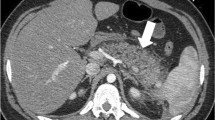Abstract
Current computed tomography (CT) grading scales are anatomic and do not reliably identify those liver injuries requiring intervention (surgery or angioembolization). We propose a clinically relevant CT grading system that could predict need for intervention. CT scans of 11 patients with hepatic injury were reviewed to establish criteria that correspond with intervention. Five features were identified that were associated with intervention: laceration in greater than or equal to three segments, laceration extending into the hilum, hemoperitoneum, active extravasation, and sentinel clot. Radiologists then evaluated the predictability of these criteria by analyzing 24 CT scans. Inter-observer agreement of the American Association for the Surgery of Trauma (AAST) grading system was compared to this new system. In the analysis of 24 CT scans, active extravasation and sentinel clot demonstrated the highest specificity for intervention. This new grading system had superior inter-observer agreement (k=0.56) as compared to the AAST grading system (k=0.47). Active extravasation and the presence of sentinel clot should form the foundation of a new liver grading system.


Similar content being viewed by others
References
Moore EE, Shackford SR, Pachter HL, McAninch JW, Browner BD, Champion HR et al (1989) Organ injury scaling: spleen, liver, and kidney. J Trauma 29:1664–1666
Moore EE, Cogbill TH, Jurkovich GJ, Shackford SR, Malangoni MA, Champion HR (1995) Organ injury scaling: spleen and liver (1994 revision). J Trauma 38:323–324
Mirvis SE, Whitley NO, Vainwright JR, Gens DR (1989) Blunt hepatic trauma in adults: CT-based classification and correlation with prognosis and treatment. Radiology 171:27–32
Croce MA, Fabian TC, Kudsk KA, Baum SL, Payne LW, Mangiante EC, et al (1991) AAST organ injury scale: correlation of CT-graded liver injuries and operative findings. J Trauma 31:806–812
Durham RM, Buckley J, Keegan M, Fravell S, Shapiro MJ, Mazuski J (1992) Management of blunt hepatic injuries. Am J Surg 164:477–481
Becker CD, Gal I, Baer HU, Vock P (1996) Blunt hepatic trauma in adults: correlation of CT injury grading with outcome. Radiology 201:215–220
Tarhan NC, Chung CB, Mohana-Borges AV, Hughes T, Resnick D (2004) Meniscal tears: role of axial MRI alone and in combination with other imaging planes. AJR Am J Roentgenol 183:9–15
Fang JF, Chen RJ, Wong YC, Lin BC, Hsu YB, Kao JL et al (2000) Classification and treatment of pooling of contrast material on computed tomographic scan of blunt hepatic trauma. J Trauma 49:1083–1088
Author information
Authors and Affiliations
Corresponding author
Rights and permissions
About this article
Cite this article
MacLean, A.A., Durso, A., Cohn, S.M. et al. A clinically relevant liver injury grading system by CT, preliminary report. Emerg Radiol 12, 34–37 (2005). https://doi.org/10.1007/s10140-005-0441-0
Received:
Accepted:
Published:
Issue Date:
DOI: https://doi.org/10.1007/s10140-005-0441-0




